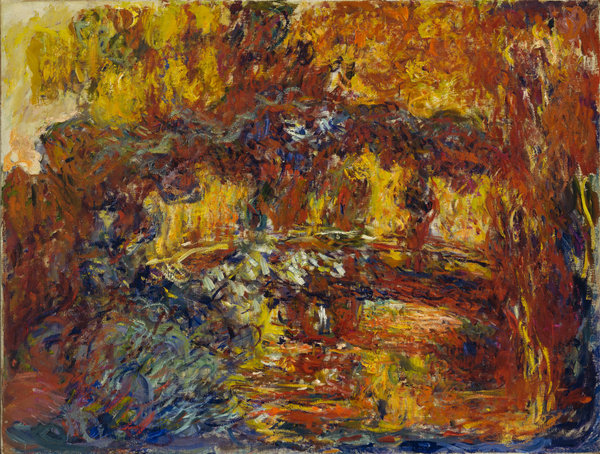Monet's Water Lilies
dal 7/9/2009 al 28/3/2010
Segnalato da
7/9/2009
Monet's Water Lilies
The Museum of Modern Art - MoMA, New York
Monet devoted the last 25 years of his life to the portrayal of the pond and its surroundings in Giverny. By the 1910s, his work centered on the creation of large-scale panels of the water lilies, a group of which he would donate to the French state for permanent installation in the Orangerie in Paris. After Monet's death, many of these last works remained in his studio, left under the care of the artist's son. But for two decades the art market and art historians reserved their interest for his earlier Impressionist work. The work of the 1910s and 1920s was regarded as far too messy and unstructured, and much of the work left in the studio was considered unfinished.

curated by Ann Temkin, The Marie-Josée and Henry Kravis Chief Curator of Painting and Sculpture, The Museum of Modern Art
The Museum of Modern Art presents Monet’s Water Lilies, an
installation that will, for the first time since the Museum's reopening in 2004, feature the full
group of Claude Monet's late paintings in the collection. These include a mural-sized triptych
(Reflections of Clouds on the Water-Lily Pond, c. 1920) and a single panel painting of the water
lilies in the Japanese-style pond that Monet cultivated on his property in Giverny, France (Water
Lilies, c. 1920), as well as The Japanese Footbridge (c. 1920-22) and Agapanthus (1918-19),
depicting the majestic plants in the pond’s vicinity. These works have long held a special status
with the Museum’s audiences and, much like the MoMA's Abby Aldrich Rockefeller Sculpture
Garden, these paintings provide a modern oasis in the center of midtown Manhattan.
These works will be complemented by a few loans of closely related paintings. The exhibition, on
view from September 13, 2009, to March 29, 2010, in the Special Exhibitions Gallery on the
second floor, is organized by Ann Temkin, The Marie-Josée and Henry Kravis Chief Curator of
Painting and Sculpture, The Museum of Modern Art.
Monet (1840-1926) devoted the last 25 years of his life to the portrayal of the pond and
its surroundings in Giverny. By the 1910s, his work centered on the creation of large-scale panels
of the water lilies, a group of which he would donate to the French state for permanent installation
in the Orangerie in Paris. After Monet's death, many of these last works remained in his studio,
left under the care of the artist's son. But for two decades the art market and art historians
reserved their interest for his earlier Impressionist work. The work of the 1910s and 1920s was
regarded as far too messy and unstructured, and much of the work left in the studio was
considered unfinished.
After the end of World War II, a sudden turnabout occurred, and art historians and
curators focused keen attention on Monet's last paintings. In a quintessential case of
contemporary art transforming attitudes toward earlier art history, the large scale and gestural
freedom of Abstract Expressionism illuminated the late Monet as a predecessor of extraordinary
relevance. In 1955 MoMA became the first public collection in the United States to acquire one of
Monet's large-scale water lilies compositions. Since then, the history of their reception has been
intertwined with the history of the Museum, both because of the water lilies' importance for scores
of contemporary artists, and for the beloved position they hold for the general audience.
The water lilies' special status was evident from the moment the first paintings came into the
collection, but it was assured when in 1958, a fire at the Museum destroyed the two late paintings
that founding MoMA director Alfred Barr, Jr., had acquired in 1955 and 1956. Widespread
mourning for these two casualties spurred the Museum quickly to replace them with the triptych
and single panel work in the present collection.
The exhibition will be accompanied by a small publication by Ms. Temkin, with Nora
Lawrence, Curatorial Assistant, that recounts the history of Monet's late works at MoMA, and
focuses on their resonance with the art and artists of our time.
Image: The Japanese Footbridge. c. 1920-22. Oil on canvas. 35 1/4 x 45 7/8" (89.5 x 116.3 cm). The Museum of Modern Art, New York. Grace Rainey Rogers Fund
Press Contact: Daniela Stigh, 212-708-9747 or daniela_stigh@moma.org
Press preview sept 8th 2009
The Museum of Modern Art - MoMa
11 West 53 Street - New York
Hours: Wednesday through Monday: 10:30 a.m.-5:30 p.m. Friday: 10:30 a.m.-8:00 p.m.
Closed Tuesday
Museum Admission: $20 adults; $16 seniors, 65 years and over with I.D.; $12 full-time students with
current I.D. Free for children 16 and under. Free for members.
Admission includes admittance to Museum galleries and film programs.
Free admission during Target Free Friday Nights 4:00-8:00 p.m.



